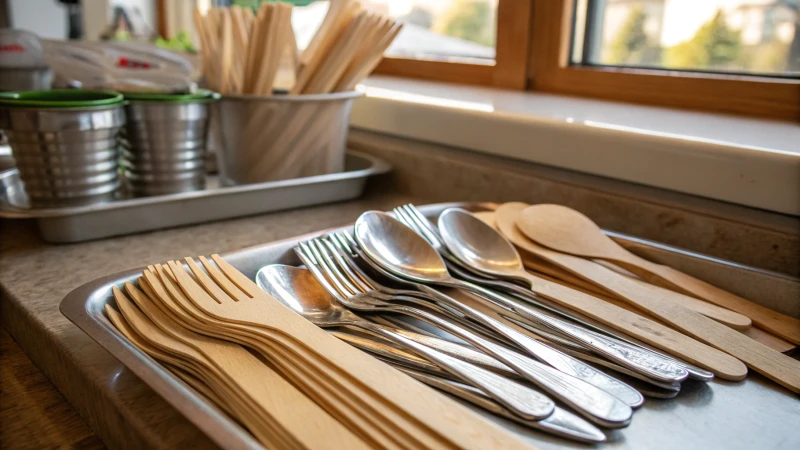
Ever wondered how your eco-friendly wooden cutlery fares against the heat of a sizzling steak or a steaming cup of soup?
Disposable wooden cutlery is less heat-resistant than metal utensils. While perfect for cold and warm meals, it can bend or break when exposed to high heat. Metal cutlery is the go-to for hot foods due to its robustness and heat endurance.
When I first switched to wooden cutlery, I was driven by a desire to be more eco-friendly. I remember organizing a picnic with my family, and as the sun set, we decided to have some hot soup. That’s when I realized the limitations of wooden cutlery—it was less sturdy when handling those steaming bowls. If you're like me, balancing sustainability with practicality, knowing when and where to use these greener options can make all the difference. Let's delve into how disposable wooden cutlery compares with trusty metal when it comes to heat handling.
Wooden cutlery warps under high heat.True
Wooden cutlery can warp when exposed to high temperatures, unlike metal.
Metal cutlery is less eco-friendly than wooden.True
Metal cutlery has a higher environmental impact due to resource extraction and manufacturing.
Why Choose Wooden Cutlery?
Imagine swapping out your usual cutlery for something more sustainable, like wooden utensils.
Wooden cutlery is an eco-friendly choice that's biodegradable and stylish. Unlike plastic, it breaks down naturally, and unlike metal, it doesn’t affect food taste with acidic reactions, making it a safe and sustainable option for dining.
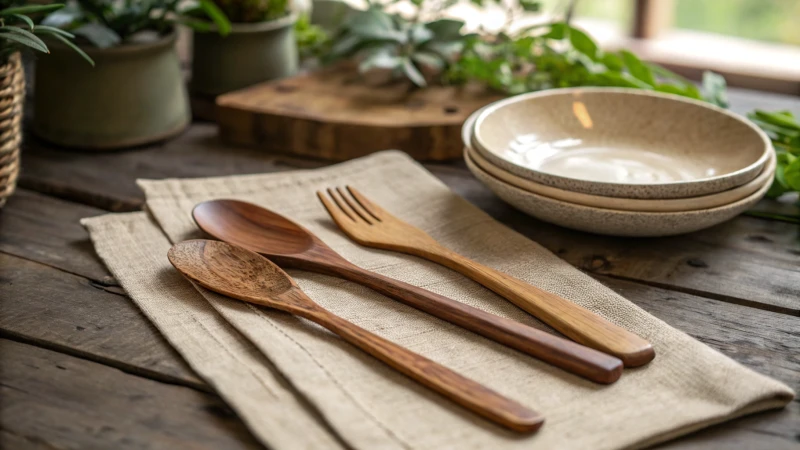
Sustainability and Environmental Impact
I remember the moment I decided to make a change. It was during a beach cleanup where I saw firsthand the impact of plastic waste. Wooden cutlery, being biodegradable1, felt like a step in the right direction. Unlike the plastic debris I picked up that day, wooden utensils naturally decompose within 6 months to 2 years. Plus, many are crafted from renewable resources like bamboo, which grows rapidly and requires minimal care.
| Material Type | Decomposition Time | Renewable Source |
|---|---|---|
| Plastic | 500+ years | No |
| Metal | Does not decompose | No |
| Wood | 6 months-2 years | Yes |
Aesthetic Appeal and Customization
There's something undeniably charming about wooden cutlery. I once hosted a garden party where I used wooden forks and spoons; they added an earthy touch to the table setting that guests couldn't stop complimenting. The warm tones and textures of wood bring an organic feel that neither plastic nor metal can match. And if you're like me, you might appreciate the opportunity for customizable options2 with your utensils, perfect for making any event uniquely yours.
Safety and Taste Integrity
I’ve always been a bit of a foodie, and one thing I love about wooden cutlery is how it doesn’t interfere with flavors. Unlike metal utensils that can sometimes leave a metallic aftertaste, wooden ones are neutral and safe. They don't conduct heat, so you can use them with hot dishes without worrying about burning your hands. And there's no risk of chemical reactions with acidic foods, which means the taste remains pure and delicious.
Versatility and Usability
Wooden cutlery fits seamlessly into a variety of settings. Whether it’s a casual picnic or a formal event, it strikes a balance between elegance and practicality. It's lightweight yet sturdy enough for everyday use, making it a go-to choice for catering businesses3 or event planners aiming to impress while staying eco-friendly. I’ve seen firsthand how these utensils can elevate an event's aesthetic while also supporting sustainable practices.
Wooden cutlery decomposes faster than plastic.True
Wood decomposes in 6 months to 2 years, while plastic takes 500+ years.
Metal cutlery is biodegradable like wood.False
Metal does not decompose; it remains intact indefinitely unlike wood.
When Does Wooden Cutlery Really Shine?
Ever wondered why wooden cutlery is gaining popularity at picnics and events? It’s not just about being eco-friendly!
Wooden cutlery shines when used in moderate temperatures and outdoor settings. It's perfect for cold meals and eco-conscious gatherings, offering a lightweight, biodegradable option.
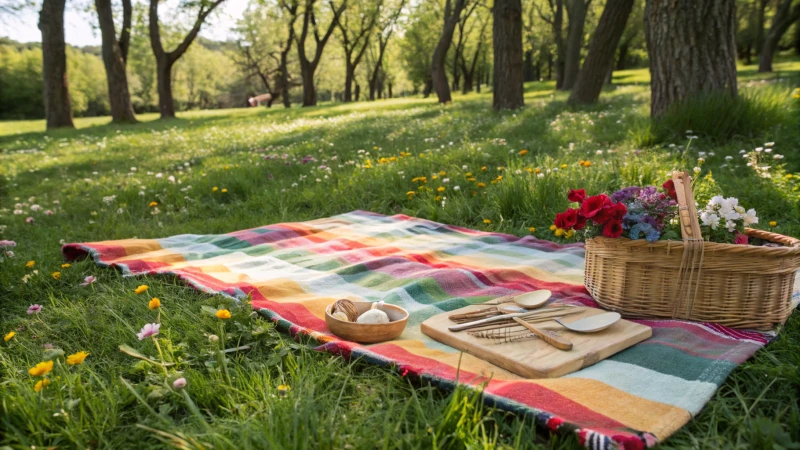
Temperature Considerations
I still remember the first time I used wooden cutlery at a family picnic. It was a warm summer day, and I was amazed at how comfortable it felt in my hand while serving salads and desserts. Unlike metal, wooden cutlery doesn’t transfer heat, which is a blessing when you're serving something warm. However, I learned the hard way not to use it for anything too hot, as the wood can warp or split. That's why wooden utensils are best for those room-temperature or cold dishes we all love.
| Condition | Performance |
|---|---|
| Moderate temperature | Ideal |
| High heat | Not recommended |
Outdoor and Eco-Friendly Settings
There's something truly delightful about using wooden cutlery at an outdoor barbecue or picnic. It's so lightweight that you barely notice you're carrying it, which is a relief when you've already got a basket full of goodies. The fact that it's biodegradable makes it a guilt-free choice, especially when hosting eco-friendly events like weddings or corporate picnics. Picture this: a rustic-themed wedding with charming wooden forks and knives that not only look great but also make cleanup a breeze.
Using wooden cutlery enhances the eco-friendly4 appeal of any event and ensures easy disposal.
Practicality in Use
The practicality of wooden cutlery really hit home during a catered event I attended. The natural look of the utensils perfectly matched the organic theme of the venue. Plus, with hygiene being a top priority, it was reassuring to know that each piece was single-use. It's important, though, to choose your supplier wisely to avoid splintering issues—nothing ruins a meal faster than a fork that breaks mid-bite.
In essence, wooden cutlery excels in specific scenarios. By selecting the right conditions and suppliers, you can enjoy both functionality and sustainability in your dining experiences.
Wooden cutlery is ideal for high-temperature cooking.False
Wooden cutlery can warp or split under high heat, making it unsuitable.
Wooden cutlery is perfect for eco-friendly outdoor events.True
It's biodegradable, lightweight, and aligns with sustainability goals.
Is Wooden Cutlery More Sustainable Than Metal?
I remember my first foray into eco-friendly cutlery, torn between the charm of wood and the reliability of metal.
Wooden cutlery is generally more sustainable due to its biodegradable nature and renewable sourcing. Meanwhile, metal cutlery boasts durability and reusability, minimizing frequent replacements.
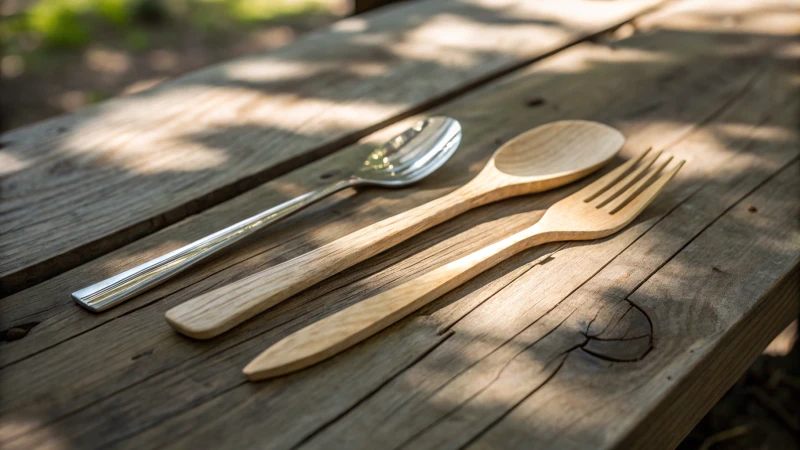
Biodegradability and Renewability
When I first started exploring sustainable options, wooden cutlery caught my eye. It's made from renewable resources like bamboo or birch, which means it can decompose naturally and reduce landfill waste. I recall the joy of discovering how easy it was to compost leftover wooden forks after a picnic. Metal cutlery, on the other hand, often involves a heavy-duty process, requiring significant energy for extraction and production.
Carbon Footprint and Energy Use
The carbon footprint of metal cutlery surprised me. Producing these utensils demands high energy consumption. I remember discussing with a friend how this impacts our overall carbon footprint. In contrast, wooden cutlery usually requires less energy to produce, especially if sourced locally. This reminded me of a small local workshop I visited once, where everything felt so much more sustainable and community-driven.
Durability and Lifecycle
There's something comforting about the durability of metal cutlery—it can last for years, reducing the need for frequent replacements. I still have a set from my grandmother that has stood the test of time! However, wooden cutlery excels in scenarios where single-use items are necessary, like at events or takeaways where convenience is key.
| Attribute | Wooden Cutlery | Metal Cutlery |
|---|---|---|
| Material Source | Renewable (e.g., bamboo) | Non-renewable (steel) |
| Biodegradability | Yes | No |
| Durability | Lower | Higher |
| Reusability | Limited | Extensive |
Environmental Certifications
In my journey to make eco-friendly choices, I've learned the importance of certifications. When choosing wooden cutlery, I always look for certifications like FSC (Forest Stewardship Council) to ensure sustainable sourcing. It's reassuring to see products aligned with sustainability goals. Metal cutlery can also come with eco-labels indicating environmentally friendly production processes.
For more information on sustainable certifications, see our guide to eco-labels5. These certifications help consumers and businesses make informed decisions aligned with their sustainability goals.
Wooden cutlery is biodegradable, unlike metal cutlery.True
Wooden cutlery decomposes naturally, while metal does not.
Metal cutlery requires more energy to produce than wooden cutlery.True
Metal production involves high energy use; wood is less energy-intensive.
How Can Wooden Cutlery Be Customized for Specific Uses?
You know, there's something special about wooden cutlery—it's not just eco-friendly but can be so uniquely tailored to any event!
Yes, wooden cutlery can be customized for specific uses by changing its design, size, or adding engravings, making it versatile for different culinary tasks or enhancing aesthetic appeal.
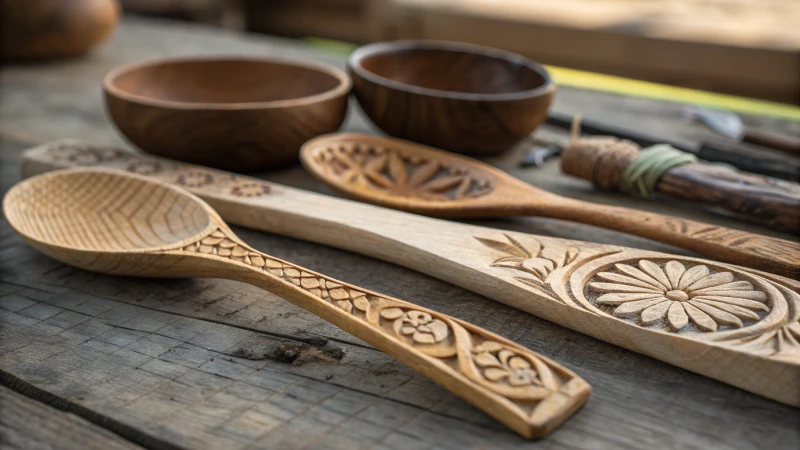
Customization Options: Design and Size
When I first discovered the charm of customizing wooden cutlery, I was amazed at the possibilities. Imagine hosting a cozy family dinner where each utensil feels like it was made just for that dish! I once had spoons crafted with larger bowls6 just for my soup-loving friends, and those sharp-edged knives were perfect for the grilled meats at our summer barbecue. It's all about finding that perfect fit, like customizing the size to achieve precision7 during meal prep or dining.
| Cutlery Type | Potential Customization |
|---|---|
| Spoons | Larger bowls, long handles |
| Forks | Pronged ends, ergonomic handles |
| Knives | Serrated edges, varied blade lengths |
Aesthetic Enhancements: Engravings and Branding
There's this magic when you add a personal touch to something as simple as cutlery. Once, I attended a wedding where every piece of wooden cutlery had a beautifully engraved logo of the couple's initials. It wasn't just a utensil; it became part of the memory. For anyone looking to add that special flair, engraving logos or designs not only enhances visual appeal but also promotes brand recall8, making every meal a reminder of the occasion.
Material Considerations: Choosing the Right Wood
Choosing the right type of wood can be like selecting the perfect wine to pair with dinner. Hardwoods like birch and maple offer durability, while softer woods allow for intricate carvings. Each type of wood brings its own unique properties, and understanding these can truly elevate your customization choices by understanding the properties9 of each wood type.
Environmental Impact: Sustainable Customization Practices
I believe in the importance of maintaining our planet's beauty while enjoying these customized touches. By selecting sustainably sourced wood and following green production processes that minimize waste, we can ensure our practices support our environmental goals. It's about making a sustainable choice without compromising quality or style by adhering to green practices10.
Wooden spoons can have larger bowls for serving soups.True
Larger bowls on wooden spoons are ideal for soup serving, enhancing functionality.
Engraving wooden cutlery does not affect brand recall.False
Engraving enhances visual appeal and promotes brand recall in events.
Conclusion
Disposable wooden cutlery is less heat-resistant than metal, making it ideal for cold or warm meals but unsuitable for high temperatures. It's eco-friendly and biodegradable, enhancing sustainability.
-
Understand the biodegradation timeline of wooden cutlery compared to plastics to appreciate its eco-friendliness. ↩
-
Explore customization possibilities for branding and aesthetic enhancement using wooden cutlery. ↩
-
Discover why catering businesses prefer wooden cutlery for its versatility and sustainable appeal. ↩
-
Learn how using wooden cutlery at events can enhance sustainability and ease waste management. ↩
-
Find out which eco-labels ensure that your cutlery meets environmental standards. ↩
-
Discover how larger bowl spoons enhance dining experiences, especially in serving liquids or thick foods. ↩
-
Explore how customized cutlery can improve precision in culinary tasks, enhancing user experience. ↩
-
Learn about the marketing benefits of engraving logos on wooden cutlery for brand visibility. ↩
-
Find out which wood types are best suited for specific cutlery functions and customizations. ↩
-
Understand how to ensure eco-friendly customization practices align with sustainability goals. ↩

